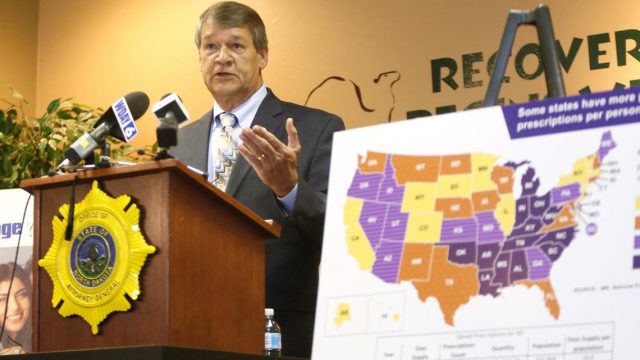The Problem for All These Opioid Lawsuits Is Germany

The State of North Dakota is suing the pharmaceutical industry over the opioid crisis (the suit was recently dismissed but apparently there will be an appeal).
In addition to the state, 19 of North Dakota’s cities and counties have also been persuaded as of June to file suit against “big pharma” as well.
Nationally, pretty much every state in the union is suing over opioids too.
What if all these legal challenges – promoted by the lawyering industry which is no doubt having flashbacks to the massively lucrative lawsuits against the tobacco industry in another era – are based on a faulty premise?
The idea is that the pharmaceutical industry flooded the market with opioid drugs which, in turn, caused an epidemic in suffering and death from opioid abuse.
Yet things are a little more complicated than that, and the situation (or lack of a situation, more accurately) in Germany seems to prove it.
Per Jacob Sullum, writing for Reason, Germany saw a massive spike in the volume of opioids being prescribed by doctors dating back to the 1990’s which isn’t at all dissimilar to what America has seen (click for a larger view):
Yet despite this similar trend, Germany has not seen a related spike in opioid addiction. “Comparisons with earlier estimates suggest that the number of persons addicted to opioids in Germany has hardly changed over the past 20 years,” a recent study published by the National Institutes for Health here in the U.S. has concluded.
In fact, both the rate of opioid-related deaths and the raw number of those deaths has actually declined in Germany per Sullum’s report:

What’s going on in Germany to explain this disparity, both with the U.S. and with other countries like Canada where the increase opioid prescriptions has correlated with a rise in opioid abuse?
It’s hard to say. The study linked above finds that Germany’s regulations and guidelines for opioid use are largely similar to those of other countries where addiction has been a problem.
There are some differences. German doctors prescribe more patches than pills to deliver opioids, and patches aren’t the preferred medium for dealers and addicts, but that hardly seems like a sufficient explanation.
Germany also has a softer sort of enforcement for drug abuse than the United States has. “Unlike the US, Germany has embraced harm reduction strategies for the treatment of substance use disorder and non-medical drug use for decades,” Dr. Jeffrey Singer, a Cato Institute fellow, writes. But, again, that seems insufficient to explain such a huge disparity.
As unsatisfying as it is as an explanation, it could be cultural. It could be that Americans, along with the citizens of other countries, are simply more prone to making bad decisions with opioids. That’s true of alcohol, as an example. Americans drink less than Europeans, but are more likely to die from drinking.
Those promoting the opioid lawsuits are suggesting a causal relationship between the presence of opioids in our society and a rise in addiction, suffering, and death. Yet not only is Germany an inconvenient truth for that argument, the experiences of several U.S. states are as well.
West Virginia, which is often touted in media reports as having the most opioid pills per capita, also has the highest rate of deaths from opioid overdoses. That would seem to support the argument of those blaming the pharmaceutical industry, but what about other states with a high number of pills per capita?
Sullum wrote about those states last month:
Of the top 10 states listed by the Post, the CDC has data on deaths involving prescription analgesics for seven. In addition to West Virginia, they are Kentucky, South Carolina, Tennessee, Nevada, Oklahoma, and Oregon, and those are not the states with the highest death rates. Within this group, Kentucky had the highest death rate in 2017 (10.2 per 100,000), but it was still lower than the rates in Maryland (11.5) and Utah (10.8), both of which had substantially lower prescription rates.
South Carolina’s death rate (7.1 per 100,000) was lower than the death rates not only in Maryland and Utah but also in Connecticut (7.7), the District of Columbia (8.4), Maine (7.6), New Mexico (8.5), Ohio (8.4), and Rhode Island (8.8). Again, all those states had lower opioid prescription rates, in some cases much lower. The same pattern holds true for Tennessee, Nevada, Oklahoma, and Oregon, all of which had lower death rates than states where fewer opioids were prescribed. The disparity is especially striking for Oregon, where the rate of deaths involving pain pills was just 3.5 per 100,000, lower than the rates in most states, even though Oregonians received more opioid prescriptions per capita than 29 states and D.C.
The pharmaceutical industry cannot be completely exonerated when we’re talking about the opioid problem here in the United States. Drug companies shipped tens of millions of pills to one West Virginia town with just a population of just a couple of thousand souls. I think it’s safe to conclude that someone at these companies knew their product was being abused and chose selling pills over doing something about it.
To the extent that’s true, the industry should be held accountable for it, but this larger argument based on a causal relationship between the presence of opioids in our society and opioid abuse is bogus.
Americans abuse opioids, yes, but is that because opioids exist? Or because many Americans for many reasons – having to do with everything from economic conditions to mental health – choose to abuse drugs and alcohol?
We might be better off figuring out why so many Americans seek the oblivion of substance abuse instead of seeking a pound of retributive flesh from the drug industry.
Of course, that approach means fewer billable hours for the lawyers.





